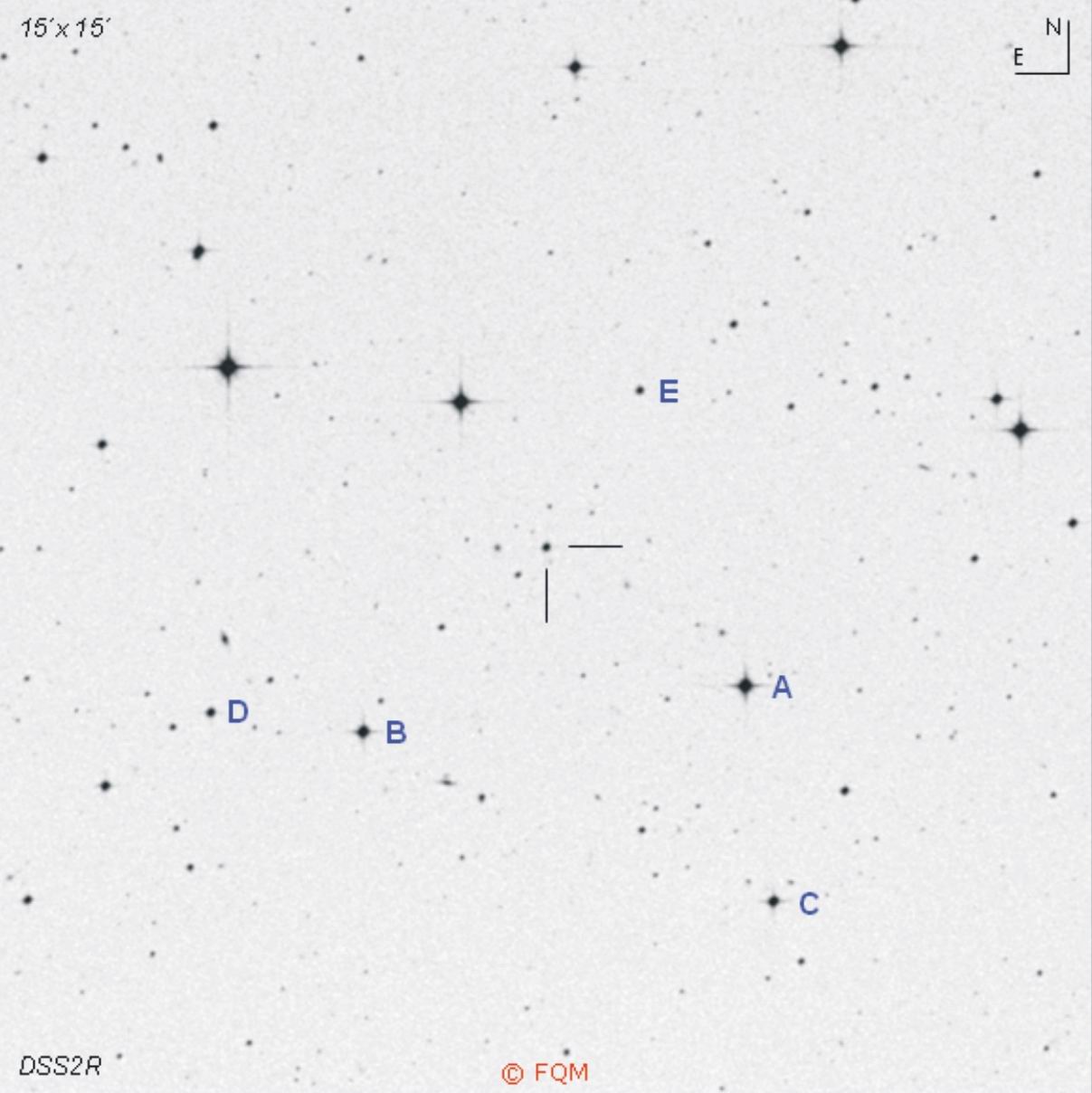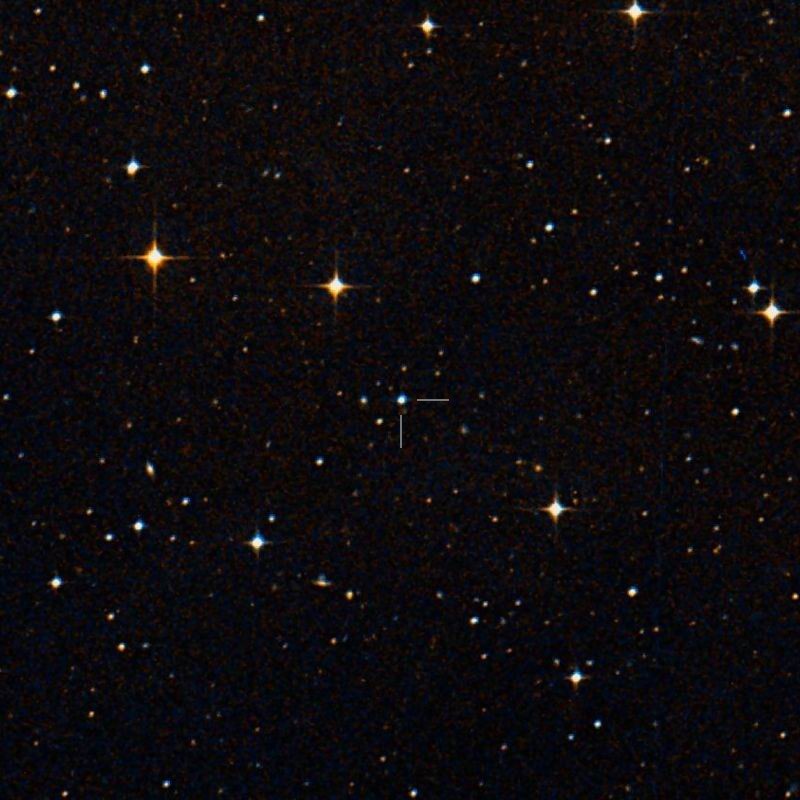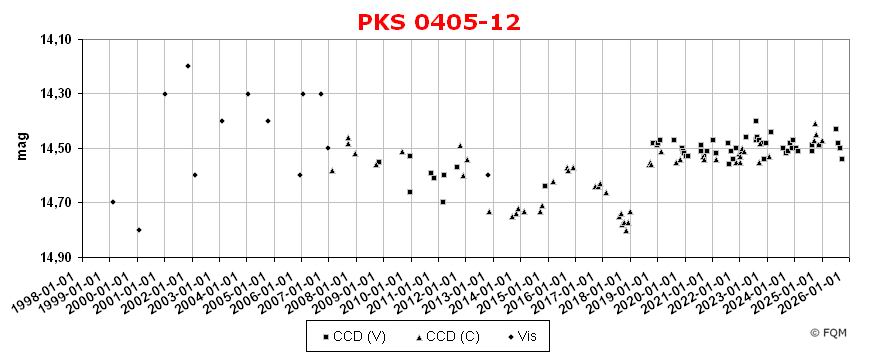
| Frankfurt Quasar Monitoring |
| PKS 0405-12 |
| Cross-Identifications | OF-109, MSH 04-102, TXS 0405-123, 0405-123 PKS 0405-123, LEDA 2823804, 1ES 0405-123 RX J0407.8-1211, 2MASSi J0407484-121136 |
| Equat. coordinates | RA 04 07 48.5 DE -12 11 36 (J2000) |
| Constellation | Eridanus |
| Type | QSO |
| Redshift |
z=0.5726 |
| Distance (2) (3) | 2057 Mpc |
| Total mag range (mv) (4) | 14.3 - 15.4 |
| Catalog Magnitude (1) | 14.86 |
| Absolute Magnitude (1) | -27.7 MB |
| Light Travel-Time (2) | 5.364 × 109 yrs |

Comparison stars
| star | B | V |
| A | 12.92 | 11.92 |
| B | 13.13 | 12.54 |
| C | 14.05 | 13.35 |
| D | 14.84 | 14.34 |
| E | 15.88 | 15.28 |


| PKS
0405-12
is a variable quasar in northern Eridanus, only 1.6° W of
planetary nebula NGC 1535, and 2.7° NE of Gamma Eridani. The
designation PKS 0405-12 refers to the Parkes Radio Survey (PKS), where
this object was cataloged as a radio source. Initially, this object was
discovered in the late 1950s as a radio source during a radio survey,
undertaken with the Sydney cross-type radio telescope (MSH). In
1966, a 16-mag stellar object was identified as the optical
counterpart of the radio source. Spectroscopic
investigations revealed a
typical Seyfert-1 spectrum, which led to the quasar classification. In
the same year 1966, the first redshift of z=0.574 was
determined. This corresponds to a cosmological distance of more than
5×109 light-years! Besides the radio, PKS 0405-12
also has been known as a source of UV, IR and
X-ray emissions. Additionally, the quasar host (LEDA) is a member of a
remote galaxy
cluster. Quasar PKS 0405-12 is often given with its other common designation OF-109. PKS 0405-12 is a small amplitude variable with a total range of about 1 magnitude in the optical. For visual observers with telescopes of at least 8- to 10-inch of aperture, this quasar is a nice observing target. It appears as a stellar object even with large aperture telescopes. CCD observers, as well as visual observers, shall use the comparison stars given above. The comparison stars C=13.35 and D=14.34 are recommended for both unfiltered and v-mag photometry. Another sequence was published by Gonzŕlez-Pérez et al. (2001). ____________
When
you are around focussing on quasar PKS 0405-12 do not miss NGC
1535, a
bright planetary nebula and a showpiece of its class, only 1.6° W of
PKS
0405-12. Those observers who like to track down some more very old quasi-stellar photons may turn to the bright and variable BL Lac object MG 0509+0541, a 15-mag object, some 23° NE in Orion. Another violently variable BL Lac object is PKS 0422+00. It can be found 13.4° NNE in southern Taurus, close to the constellation of Eridanus/Orion. |
|
Adam, G. 1985, A&AS, 61, 225; UBV Photometry of Quasars and Quasar Candidates. II. Angione, R.J. 1971, AJ, 76, 412; Photoelectric Sequences for the Brighter QSO´s. Angione, R.J. 1973, AJ, 78, 353; QSO historical Light Curves. Angione, R.J., Moore, E.P., et al. 1981, AJ, 86, 653; Optical Monitoring of 15 Quasars. Bolton, J.G., et al. 1966, ApJ, 144, 1229; Radio and Optical data on Fifteen Quasi-Stellar Objects. Bolton, J.G., Ekers, J. 1966, AuJPh, 19, 559; Identification of strong Extragalactic Radio Sources in the Declination Zone 0° to -20°. Boyce, P.J., Disney, M.J., et al. 1999, MNRAS, 302, 39L; Quasar Host Galaxy Images from the Hubble Space Telescope Archive. Brotherton, M.S. 1996, ApJS, 102, 1; The Profiles of H beta and [O III] Lambda 5007 in Radio-loud Quasars. Craine, R.E.; A Handbook of Quasistellar and BL Lacertae Objects; Parchart Publishing House, Tuscon 1977. Gonzŕlez-Pérez, J.N., Kidger, M.R., et al. 2001, AJ, 122, 2055; Optical and Near-Infrared Calibration of AGN Field Stars: An All-Sky Network of faint Stars calibrated on the Landolt System. Green, R.F., Pier, J.R., et al. 1980, ApJ, 239, 483; Observation of Quasars with the International Ultraviolet Explorer Satellite. Hansen, T. 1991, Deep Sky Magazine 34, 32; The "Deepest" Deep Sky Objects. Harrington, P. 1994, Astronomy 6/1994, 56; Tracking down a Quasar. Karge, S.; Helle Quasare für 8- bis 10-Zoll Teleskope. Ein Beobachtungsführer zur visuellen Beobachtung von Quasaren und BL Lacertae Objekten; Frankfurt 2005. Kinman, T.D. 1967, ApJ, 148, L53; Optical Polarization Measures of Five Radio Sources. Kinman, T.D., Burbidge, E.M. 1967, ApJ, 148, 59L; Spectroscopic Observations of Nineteen Quasi-Stellar Radio Sources. Kirhakos, S., Sargent, W.L., et al. 1994, PASP, 106, 646; The HST Quasar Absorption-Line Key Project. VIII. CCD Imaging of Hubble Space Telescope Quasar Fields. Mills, B.Y., Slee, O.B., Hill, E.R. 1958, AuJPh, 11, 360; A Catalogue of Radio Sources between Declinations +10° and -20°. Richards, G.T., Yanny, B., et al. 1997, PASP, 109, 39R; Quasar Photometry with the SDSS Monitor Telescope. Selmes, R., Tritton, K., Wordsworth, R. 1975, MNRAS, 170, 15; Optical Monitoring of Radio Sources- IV. Results up to 1973 April. Steinicke, W.; Katalog heller Quasare und BL Lacertae Objekte; Umkirch 1998. Steinicke, W.; Beobachtungsliste für helle Quasare; Umkirch 1999. Takalo, L.O., Kidger, M.R., et al. 1992, A&A, 261, 415; First simultaneous UBVRI photopolarimetric Observations of a Sample of normal Quasars. Véron-Cetty, M.-P., Véron, P. 2001, A&A 374, 92; A Catalogue of Quasars and Active Nuclei: 10th edition. Véron-Cetty, M.-P., Véron, P. 2003, A&A 412, 399; A Catalogue of Quasars and Active Nuclei: 11th edition. Véron-Cetty, M.-P., Véron, P. 2006, A&A 455, 776; A Catalogue of Quasars and Active Nuclei: 12th edition. Véron-Cetty, M.-P., Véron, P. 2010, A&A 518, 10; A Catalogue of Quasars and Active Nuclei: 13th edition. |
| Link: Hamburg Quasar Monitoring |
| home |